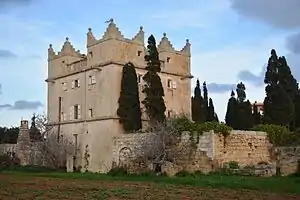Bubaqra Tower
Bubaqra Tower (Maltese: Torri ta' Bubaqra), formerly named as Saliba Tower,[2] is a fortified house in Bubaqra, limits of Żurrieq, Malta. It was built as a country retreat in the late 16th century. The tower and its gardens have been restored, and now serve as a family retreat. It is officially named as Bubaqra Palace (Maltese: Palazz Bubaqra) and it is a grade 2 national monument.
| Bubaqra Tower | |
|---|---|
Torri ta' Bubaqra | |
 View of Bubaqra Tower | |

| |
| General information | |
| Status | Intact |
| Type | Fortified house |
| Location | Bubaqra, Żurrieq, Malta |
| Coordinates | 35°49′30.6″N 14°28′33″E |
| Completed | c. 1579 |
| Renovated | 18th century |
| Owner | Polly Fry[1] |
| Technical details | |
| Material | Limestone |
| Website | |
| www.bubaqra-tower.com | |
History
Bubaqra Tower was built in around 1579 by Don Matteolo Pisani, a Conventual Chaplain of the Order of St. John.[3] Fr. Luret Zammit confirms that it was built by Fr. Mattew (Matteolo) Pisani. Zammit says that it was eventually named Torre del Greco for a Greek family, the Roncali family, who lived there.[4]
Although the structure was fortified, it was privately owned and was not meant for defensive purposes. Despite this, at some point it was probably used in Malta's defence system, as was done in other cases such as Gauci and Mamo Towers.[5]
The structure was modified in the 18th century,[6] during the rule of Grand Master Marc'Antonio Zondadari and around 1760,[4] when four turrets were also added giving it a fortified residence appearance from the distance.[7]
It was reportedly used as an illicit meeting place between members of the Order, who were bound by vows of celibacy, and young females.[6] During this period, it was common for the knights, priests and bishops to have mistresses, illegitimate children, or both; notably, the parish priest of the village of Żurrieq himself was known to organise meetings against payment between young mistresses and their knightly suitors in the whereabouts of the tower.[8][9]
The tower was requisitioned by the British military during World War II between 1939 and 1945,[4] but was returned to its owners after the war.[10] Thereafter, Bubaqra Tower and its gardens were restored,[6] and the place was turned into a family retreat.[11] The tower is listed on the National Inventory of the Cultural Property of the Maltese Islands.[12] The building is officially known as Palazzo Bubaqra by the Malta Environment and Planning Authority (MEPA) and is scheduled as a grade 2 property.[13]
Architecture
Bubaqra Tower is situated in an agricultural estate, in Bubaqra[14] where it is surrounded by citrus gardens.[3] It is square in shape, and has four distinctive corner turrets.[12] Its architecture probably influenced the design of the Gourgion Tower, which was built in the late 17th century on Gozo.[3] Above the main entrance of the building is an inscription that calls upon God to give relief from the enemy at the recitation of the sign of the cross.[4]
Further reading
- Mahoney, Leonard (1996). 5000 Years of Architecture in Malta. Valletta Pub. pp. 89–108. ISBN 9789990958157.
- Malte. Random House Incorporated. 2001. pp. 82–84. ISBN 9780847822867.
References
| Wikimedia Commons has media related to Bubaqra Tower. |
- Fry, Polly (7 June 2016). Castle in Malta with private 5 acre walled garden and pool.. HomeAway. Retrieved 16 June 2016.
- "pp.96-97" (PDF). Melitensiawth.com. Retrieved 7 July 2018.
- Azzopardi, Joe (October 2013). "The Gourgion Tower – Gone but not Forgotten (Part 1)" (PDF). Vigilo. Din l-Art Ħelwa (44): 46. ISSN 1026-132X. Archived from the original (PDF) on February 11, 2014.
- Guillaumier, Alfie (2005). Bliet u Rhula Maltin. 2. Klabb Kotba Maltin. p. 1028. ISBN 99932-39-40-2.
- "Zurieq – Blue Grotto". maltassist.co.uk. Archived from the original on 28 March 2014.
- Attard, Mary (22 November 2014). "Preti, Ball and catacombs". Times of Malta. Archived from the original on 20 November 2015.
- "Preti, Ball and catacombs". Timesofmalta.com. Retrieved 7 July 2018.
- Attard, Robert; Azzopardi, Romina (2010). Daily life in 18th century Malta. Midsea Books. ISBN 978-99932-7-327-1.
- Wettinger, Godfrey (1977). "Concubinage among the Clergy of Malta and Gozo ca. 1420-1550" (PDF). Journal of the Faculty of Arts. University of Malta. 6 (4): 165–188.
- "Bubaqra Tower". Gozo Tourism Association. Archived from the original on 20 November 2015.
- "About". bubaqra-tower.com. Archived from the original on 11 August 2015.
- "Bubaqra Tower" (PDF). National Inventory of the Cultural Property of the Maltese Islands. 28 June 2013. Retrieved 20 November 2015.
- "Government Notices: No. 835". Malta Environment and Planning Authority. 9 September 2013. p. 10,250. Archived from the original on 15 March 2016.
- Abela, Giovanni Francesco (1647). Della Descrizione di Malta Isola nel Mare Siciliano con le sue Antichità, ed Altre Notizie (in Italian). Paolo Bonacota. p. 95.